In case of poor recording and poor playback chain I admit that some added noise and distortion may make the file more acceptable. But I do not agree with such approach, IMO the system should be as transparent as possible.
In sympathy with your opinion, I will explain a proven situation where hardware can change preference.
Many amp designers seem have no idea of what they have compromised when they opted for sub ppm THD (they have to study by themselves to find out what it is!).
As an analogy, many power opamps have specified their performance under lower feedback than their suggested application. Is this to ensure stability? No. With resistive load the performance will be better with lower FB but in most applications the higher FB will win. Is this cheating? No. If you can give suitable load such as full range speakers, the low FB will win due to lower THD. But with multi way passive crossover the higher FB will win because it drives better.
Now, what is the sound of "having insufficient drive"?
You will perceive high effort to move the speaker and the sound is perceived slower in transient. In general this is not musical. Many amps with lack of drive like this will be abandoned by the user after some period of using!
Phase issue will affect musicality too. Theoretically, improper phase will change amplitude, but I think it is much worse than that! It will also change the pitch of the music.
In one of the file here (pear vs apple), the musicality has been compromised. I believe it is phase issue instead of drive ability issue. Any additional circuitry will affect phase so I believe the non musical one is not direct, regardless of hardware quality/transparency.
A musical sound, you can follow easily when you move your body (tap your foot) to tune in with the music. You can even feel it if you try to sing along where you can feel if the instrument is out of tune with the music. Well, phase issue is a terrible thing if you can recognize it. My concern has been, even if people cannot recognize it on the spot, it will still affect them, so no excuse to use poor system just because you cannot hear differences. I believe PMA would agree.
Now one rethorical question from another thread: is golden ear a blessing or a curse?
In one of the file here (pear vs apple), the musicality has been compromised.
So, what do you think? Which of these files do you prefer to listen. It has been already revealed which is the original file, unaffected by additional hardware manipulation.
http://www.diyaudio.com/forums/ever...stening-test-trial-no-3-a-10.html#post3729383
So, what do you think? Which of these files do you prefer to listen.
As I have mentioned few posts above, I brought the wav files from office and couldn't play them on my toy player, unfortunately.
Then I am sorry, I have understood from your post above that you have considered one of the files as more musical. The files are in 48kHz/24bit wav format:
File Type: 48000Hz, 32-bit, Stereo
Uncompressed Size: 48,29 MB (50*637*272 bytes)
File Format: Windows PCM
24-bit Packed Int (type 1 (24-bit))
File Type: 48000Hz, 32-bit, Stereo
Uncompressed Size: 48,29 MB (50*637*272 bytes)
File Format: Windows PCM
24-bit Packed Int (type 1 (24-bit))
Letting the music "wash over" you is an excellent approach, you almost don't listen to it, you let your mind wander to another place - and every now and again you let your mind's focus slip back directly to the music. If you have to "work" to listen to the music, concentrate on it, then the sound is not "right" - long term listening this way will lead to fatigue and loss of interest ...This is the first test I have done where I listened from the beginning and it was more effective than I thought. Previously I had tried to pick short segments in a track where I felt there should be some identifiable sonic difference rather than just letting the track "wash over" me from the start. That approach failed miserably on the Apple vs Pear where I just listened in a relaxed state of mind to the music from the start.
BTW, I believe that PMA would agree with me that 5/5 is not sufficient. I propose 8/8 (0.4% probability of guessing). 5/5 is too easy like guessing.
5/5 is 3.125% probability of guessing, 8/8 is 0.39% probability of guessing. Even 3.125% is a very low probability.
It really does require a relaxed form of concentration to hear differences between pear and apple.
It isn't clicks and pops of foobar ABX. Last night I did trials using fixed starting point, using section with sax line with lots of sustained notes and runs.
A certain warm up period seemed necessary, then I got a good run:
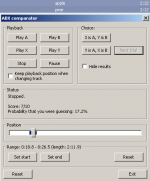
As testing continued I became habituated to both sounds, and found that I needed to pause for >30 seconds to relax before doing next trial, and also found that if I couldn't clearly tell difference in <20 seconds that I tended to guess, but if I paused and waited to relax that I could identify differences.
I continued above trial and got to here:
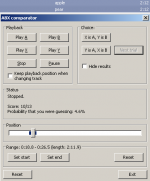
I paused for a few minutes, but my partner came home, and I got distracted.
So what are identifiable differences used as differentiation cues?
If linear impulse response of DA>AD chain is convolved with music track, and the resulting pair aligned, are the two conditions identifiable with ABX?
It isn't clicks and pops of foobar ABX. Last night I did trials using fixed starting point, using section with sax line with lots of sustained notes and runs.
A certain warm up period seemed necessary, then I got a good run:

As testing continued I became habituated to both sounds, and found that I needed to pause for >30 seconds to relax before doing next trial, and also found that if I couldn't clearly tell difference in <20 seconds that I tended to guess, but if I paused and waited to relax that I could identify differences.
I continued above trial and got to here:

I paused for a few minutes, but my partner came home, and I got distracted.
So what are identifiable differences used as differentiation cues?
If linear impulse response of DA>AD chain is convolved with music track, and the resulting pair aligned, are the two conditions identifiable with ABX?
So what are identifiable differences used as differentiation cues?
Musicality (read previous posts for details). I can listen on any part of the file. I didnt set the *end* as i can push the *stop* once i recognize which file it is. Sometimes i can recognize it in just one second if the *start* is set just before a drum hit (inferior file has false deep bass and long decay, that makes it out of tune with the rest of the music)
Musicality and fatigue are two basic performance indicators before the other preferences such as soundstage.
Yes, this is cue that indicates potential audibility of group delay. Other view of this is that bandwidth of signal exceeds bandwidth of playback system so that some form of aliasing occurs.
If you can hear difference, then why not get into spirit of thread and post some ABX results?
PMA;
Why did you delay pear by 11 samples?
If you can hear difference, then why not get into spirit of thread and post some ABX results?
PMA;
Why did you delay pear by 11 samples?
I just applied 2.4Hz Butterworth filter to pear three times to emulate DA>AD process used to generate apple.
With foobar ABX this is my 10 trial score:
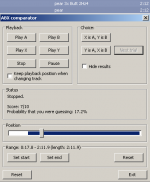
I've uploaded the modified pear file to a drop box with link here for anybody who would like to give it a whirl.
Now I will create files with cascaded Butterworth filterings as normal versions and linear phase versions with identical frequency response and see how they compare.
With foobar ABX this is my 10 trial score:

I've uploaded the modified pear file to a drop box with link here for anybody who would like to give it a whirl.
Now I will create files with cascaded Butterworth filterings as normal versions and linear phase versions with identical frequency response and see how they compare.
It really does require a relaxed form of concentration to hear differences between pear and apple.
It isn't clicks and pops of foobar ABX. Last night I did trials using fixed starting point, using section with sax line with lots of sustained notes and runs.
A certain warm up period seemed necessary, then I got a good run:
As testing continued I became habituated to both sounds, and found that I needed to pause for >30 seconds to relax before doing next trial, and also found that if I couldn't clearly tell difference in <20 seconds that I tended to guess, but if I paused and waited to relax that I could identify differences.
I continued above trial and got to here:
I paused for a few minutes, but my partner came home, and I got distracted.
Perfect! It is really not easy to get a repeatable result in case the sound difference is small and it of course depend on our momentary condition, ability to be relaxed when listening etc.
PMA;
Why did you delay pear by 11 samples?
No intention here. I tried to cut the beginning of the files to make them as aligned as possible. 11 samples makes 229 microseconds.
Regarding pear (original) x apple (D/A - A/D) : I am not surprised at all that there are some slight audible differences. 1st, the D/A - A/D path introduces some additional noise. This is a fact. 2nd, there are opamps both in output stage of D/A and input stage of A/D. If I was able to tell 5 x NE5532 unity gain against wire in ABX test, no wonder we can tell the difference against D/A - A/D. Almost anything placed into the audio chain makes an audible difference. It is more difficult to verify it in ABX than during relaxed listening, but it is possible, as we can see.
Last edited:
Look at diff file of pear v with the 3x cascaded Butterworth filtering:
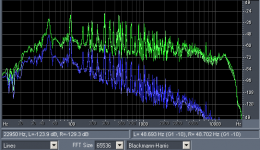
Wide separation at high frequencies show that these all match very well. Differences accumulate at low frequencies with group delay. Listening occurs with exact same electronics, yet are relatively easy to tell apart with foobar ABX.
I've generated the next comparison files with 4x cascaded 2.4Hz Butterworth filters, one is normal IIRC and the other 2x cascading 2.4Hz Butterworth filter was done, the waveform time reversed, 2x cascading 2.4Hz Butterworth filtering, followed by time reversal to normal direction.
4x cascaded Butterworth
4x cascaded Butterworth linear phase
Additionally I created wave file of 4x cascaded Butterworth filters; linear phase is left channel and normal filter is right channel: link
These filters may be convolved with any signal to get filtered versions.
I've done foobar ABX of pear with 4x cascaded Butterworth filter. It was relatively easy to tell them apart compared to differentiating pear with 3x cascaded Butterworth filter.
To make it a little different, does 100 percent guessing result mean that I'm a good guesser?
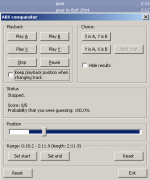
After a break I will try ABX with linear phase filter.

Wide separation at high frequencies show that these all match very well. Differences accumulate at low frequencies with group delay. Listening occurs with exact same electronics, yet are relatively easy to tell apart with foobar ABX.
I've generated the next comparison files with 4x cascaded 2.4Hz Butterworth filters, one is normal IIRC and the other 2x cascading 2.4Hz Butterworth filter was done, the waveform time reversed, 2x cascading 2.4Hz Butterworth filtering, followed by time reversal to normal direction.
4x cascaded Butterworth
4x cascaded Butterworth linear phase
Additionally I created wave file of 4x cascaded Butterworth filters; linear phase is left channel and normal filter is right channel: link
These filters may be convolved with any signal to get filtered versions.
I've done foobar ABX of pear with 4x cascaded Butterworth filter. It was relatively easy to tell them apart compared to differentiating pear with 3x cascaded Butterworth filter.
To make it a little different, does 100 percent guessing result mean that I'm a good guesser?

After a break I will try ABX with linear phase filter.
Comparison of pear v pear with 3x cascaded 2.4Hz Butterworth filter is half of equation with a comparison of apple v pear with 3x cascaded 2.4Hz Butterworth filter.
Such filtering removes high pass filtering of signal as possible difference that is discriminator. It leaves noise and other distortions as possible discriminating factors.
Here is my first go at apple v pear with 3x cascaded Butterworth filter:
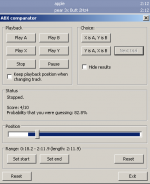
4 out of 10 is rough territory. It could be expectation bias, or fatigue.
I encourage others to try these comparisons.
Such filtering removes high pass filtering of signal as possible difference that is discriminator. It leaves noise and other distortions as possible discriminating factors.
Here is my first go at apple v pear with 3x cascaded Butterworth filter:

4 out of 10 is rough territory. It could be expectation bias, or fatigue.
I encourage others to try these comparisons.
I don't understand what you mean with "rough" territory.4 out of 10 is rough territory.
Theoretically, 5/10 is PURE guessing. Knowing a lot of things including how random numbers are generated in computer I would propose 6/10 as the mid value of pure guessing.
Comparison of pear v pear with 3x cascaded 2.4Hz Butterworth filter
Such filtering removes high pass filtering of signal as possible difference that is discriminator. It leaves noise and other distortions as possible discriminating factors.
Can you explain more clearly what you are trying to achieve? Including How the ABX result should form the conclusion?
You are comparing two original files excep one has hpf. If sound difference can be perceived (eg 7/7), it means?
Having a quick listen in Nero, and Audacity, can't pick an audible difference ...I've uploaded the modified pear file to a drop box with link here for anybody who would like to give it a whirl.
Comparisons of pear, apple, and my modified pear files indicate that group delay is primary audible feature.
1) pear v apple shows that group delay or other feature make discrimination possible.
2) pear v pear with group delay eliminates noise and other features as source of discrimination.
3) apple v pear with added group delay cannot (thus far) be discriminated, indicating noise and distortion of apple's DA>AD process is not discriminating feature.
With 4 out of 10 result is more random v negative correlation that would form with 3 out of 10 result. Ability to discriminate in case 3) leaves possibility of discriminating against unintended effects of electronics. Not being able to discriminate in case 3) suggests that electronics in apple path are blameless, beyond adding readily identifiable high pass filter. This filtering can be completely avoided with DC coupled circuits, or if trying to compare different components, such as op amps, that comparisons must be done using circuits that have highly matched pass band characteristic.
Frank;
Are you using headphones/ear buds or speakers to make comparisons?
1) pear v apple shows that group delay or other feature make discrimination possible.
2) pear v pear with group delay eliminates noise and other features as source of discrimination.
3) apple v pear with added group delay cannot (thus far) be discriminated, indicating noise and distortion of apple's DA>AD process is not discriminating feature.
With 4 out of 10 result is more random v negative correlation that would form with 3 out of 10 result. Ability to discriminate in case 3) leaves possibility of discriminating against unintended effects of electronics. Not being able to discriminate in case 3) suggests that electronics in apple path are blameless, beyond adding readily identifiable high pass filter. This filtering can be completely avoided with DC coupled circuits, or if trying to compare different components, such as op amps, that comparisons must be done using circuits that have highly matched pass band characteristic.
Frank;
Are you using headphones/ear buds or speakers to make comparisons?
Comparisons of pear, apple, and my modified pear files indicate that group delay is primary audible feature.
Well for me it is obvious, as this is the conclusion that I want to "share" by joining these threads.
Before I did it in speaker forum, saying that transmission line enclosure is not to be used in ultimate speaker due I believe a group delay and Doppler distortion that I linked to the bass performance. Of course, people will say that I just never heard a good TL.
But I hope I can still bring surprises. Which files that you think cannot be positively ABXed? What guessing probability do you think I cannot surpass? 10/10? Hehe.
I don't have computer at home right now to ABX thru my transparent speakers. At office it was public pc with poor soundcard and uncomfortable surroundings. So do not expect 8/8 please 😀
Small PC speakers, zero below 100Hz response, so that should make things harder, 🙂. I might do some experiments, to see if I can tune into a difference ...Frank;
Are you using headphones/ear buds or speakers to make comparisons?
Is there anyone who has not been completely tired yet? 🙂
If yes, then there is a new test:
https://www.dropbox.com/s/b6q9le2kw5ls5i2/kiwimike.zip
with really very subtle differences between two sound files. The song is still the same. Anyone can get a positive ABX result? And sound impressions and preferences? Thanks!
If yes, then there is a new test:
https://www.dropbox.com/s/b6q9le2kw5ls5i2/kiwimike.zip
with really very subtle differences between two sound files. The song is still the same. Anyone can get a positive ABX result? And sound impressions and preferences? Thanks!
- Status
- Not open for further replies.
- Home
- General Interest
- Everything Else
- Ultimate listening test - trial no. 3